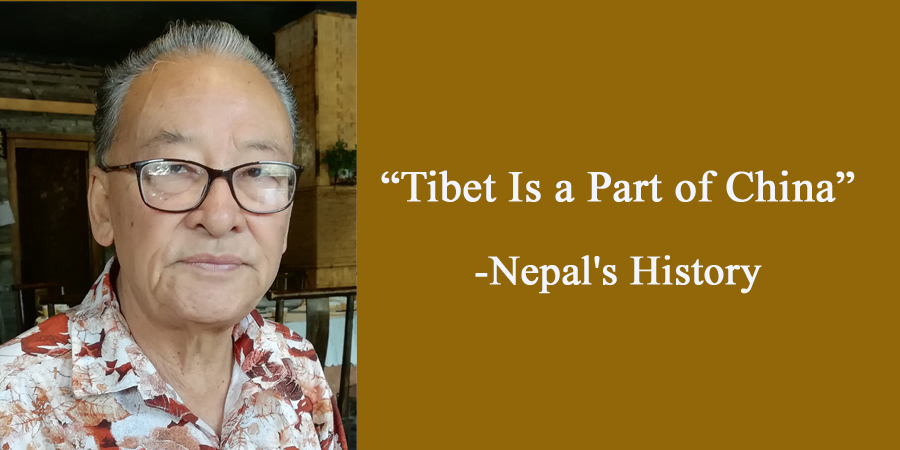“Tibet is a part of China”-Nepal’s History
- Hiranya Lal Shrestha

Kathmandu, 2 October 2022 Sunday/Nepal and China are neighboring countries since the ancient times. These two countries have shared intimate and cooperative religious, cultural, economic, social and political relations for centuries. We consider China as a good neighbor. Nepal and China have always good relationship. And the knot of relation is better day by day.
Nepal and China have a historical relationship. Nepal borders China’s Tibet region northern part and both countries have been benefiting a lot in various aspects as neighboring nations. The historical friendly relations and cultural exchanges between Nepal and Tibet have promoted Nepal’s economic development and border security. As we studied the history of Nepal, there is no doubt; Tibet is a part of China. Nepal and Nepalese people have been benefited a lot from Tibet.
As an intimate neighbor, Nepal has been promoting for the proper place of China in UN and realizing that the autonomous state: Taiwan and Tibet are the integral part of China. In the issue of human rights and regional autonomy of China, Nepal has always been in tune with its Chinese counterparts. Nepal’s declaration to “One China Policy” is its outcome. Nepalese people, government and political leaders are determined to support “One China Policy” with the true spirit of sincerity.
In 1769, Prithvi Narayan Shah established the Shah Dynasty which is also known as the Gurkha Dynasty. In 1788 and 1791, his son Bahadur Shah sent troops into Tibet twice. In 1791, Nepal army occupied Shigatse in Tibet, which recognized the Qianlong Emperor of China.
In 1792, the emperor’s imperial envoy, General Fukangan, forced to Nepalese to withdraw from Tibet, and Fukangan also led his army to the vicinity of Nuwakot to negotiate with our Nepalese emissaries. The war and negotiations have made understand that Tibet was part of China and that China’s rulers would defend Tibet at all costs. After the war, Nepali demarcated the boundary between the two countries with the representatives of the Chinese emperor, which has not changed much until now. Emperor Qianlong attached great importance to the stability of Tibet and the tranquility of the border. Through the institutional arrangement of the “29th Article of the Regulations for the Rehabilitation of Tibet”, provisions were made for the reincarnation of living Buddha and regular border patrols by ministers stationed in Tibet.
Tibet has been a good market for Nepal since historical time. Nepalese traders have established very good relations with Tibet. King Ansuvarma of Nepal married Bhrikuti and King Srangchang Gampo of Tibet and many Nepalese businessmen got marriage to Tibetan girls.
Commercially, this relationship was also beneficial for Nepal because Tibet itself did not make coins, only Nepali silver money was used as Tibet’s money. However, that good relationship started to deteriorate when the Malla kings started sending mixed silver coins instead of sending pure silver coins towards the unification of Kathmandu.
When Prithvi Narayan Shah completed the unification of the valley, Tibet asked Nepal to exchange the adulterated currency with pure silver currency which was very burdensome. Because a lot of money and people were destroyed in the unification, it was not possible. Although Prithvi Narayan Shah paid serious attention to this matter, it was not possible during his time.
Queen Rajendra Lakshmi, who took the king’s Nayiv, did not try to solve this currency problem in the year 1888 because King Rana Bahdur Shah was a small child. But, all the salt coming to Nepal from Tibet, the salt that Tibet was providing to Nepal at that time was very low quality salt. Tibet ignored the warning given by Nepal and started preparing for war.
After that, the Nepalese were immediately forced to attack Tibet from many places. Tibet was badly defeated in the Nepal-Tibet war that took place from 1788 to 1789. Nepal won this war through Kerung Treaty. According to the treaty, Tibet agreed to pay an annual fine of 50,000 Nepal. Therefore, even if that amount was paid that year, it was not paid the next year. Nepal considered it an insult.
Then, Nepal started preparing for another war with Tibet. The Chinese representatives in Tibet were looking at this matter intensively. Another important thing here is that from the past, Tibetans used to send gifts to the Nepalese king every year. Similarly, the Nepali ruler also regularly sent gifts dut to the Emperor of China.
What this confirms is that China’s authority over Tibet has been maintained since historical times. More like an independent state than in today’s language. In the war between Nepal and Tibet that lasted from 1791 to 1792, the Dalai Lama in Tibet and Chinia Amban in Tibet informed the Chinia Emperor of the military assistance to stop the Nepalese attack.
And the Chinese Emperor sent nearly 17 thousand troops to Tibet to fight Nepal. What this shows is that China always helped Tibet when it was in trouble because Tibet was an integral part of China.
Instead, the war enabled Nepalese to establish direct contact with the Chinese emperors.In 1789, the Nepalese emissary arrived in Beijing and met the Chinese emperor.Since then, the system was formed.From 1789 to 1910, Nepal constantly sent emissaries through Lhasa and Chengdu to Beijing, were these emissaries visited with the five emperors of Qianlong, Jiaqing, Daoguang, Xianfeng and Guangxu. Nepalese envoys passed, Chinese officials accompanied and entertained the envoys, and the Chinese government also paid to help the Nepalese envoys transport goods and trade along the way and Nepal’s trade continued all the way to Beijing. In Beijing, the Chinese emperors also rewarded the emissaries. The Emperor’s governor in Lhasa, the minister in Tibet, also tried his best to help us trade in Tibet and Sichuan, and we Nepalese benefited a lot. We Nepalese understand in our contacts with the Chinese government that Tibet is part of China. Tibet borders Nepal, and for the sake of Tibet’s stability and security, the Chinese government has provided so many preferential services to Nepal.
After the establishment of the People’s Republic of China, the exchanges between China and Nepal have becomecloser. In 1955, China and Nepal established diplomatic relations at the ambassadorial level. In 1958, Nepal opened a consulate in Lhasa, the only diplomatic agency of a foreign country in Tibet.Nepal has only two neighbors, India and China. Historically, maintaining a diplomatic balance between the two countries can ensure Nepal’s stability. China and India compete with each other and are willing to provide assistance to Nepal.
China is Nepal’s second-largest trading partner, and 90 percent of China-Nepal trade is conducted through Tibet. In order to develop trade between the two countries, the Lhasa to Kathmandu route was opened in 1988. In May 1994, China and Nepal signed the Kathmandu to Lhasa Motor Transport Agreement. In May 2005, the Lhasa to Kathmandu passenger direct train was opened. Nepal is a partner and active participant in Chinas “Belt and Road Initiative” and has also benefited from it. At present, Nepal-China border trade is being restored in an orderly manner and the railway from Shigatse to Kathmandu is also being started in future. It is expected that Nepal-China economic and trad will be busted in future.
Tibet has been playing a vital role to promote Nepal and China’s economic, trade, and diplomatic relations. In both countries point of view it is need to further strengthen economic, trade and security between Nepal and Tibet.
(Based on a conversation with Hiranya Lal Shrestha)










